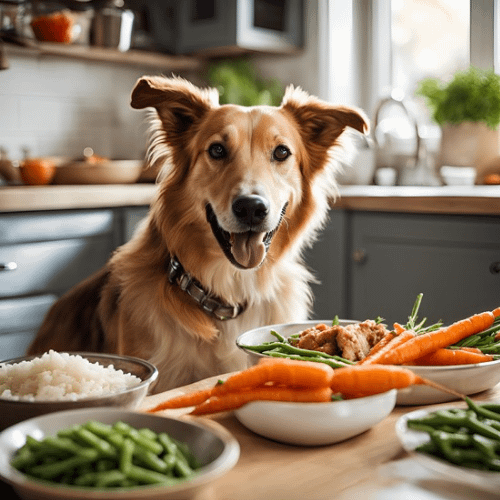A Simple Starter Guide to Home Cooking for your Dog

Cooking for your dog at home can be a rewarding experience that allows you to control the ingredients and ensure your furry friend receives a nutritious diet. This guide will cover everything you need to know about preparing homemade meals for your dog, including what to include and what to avoid.
In our home, mealtimes each day are very special and intimate bonding times with our rescue dog, Mr Fitch. He just loves being fed by us and watching all the ingredients cook. It’s a special event for all of us, and we get to do it twice each day.
1. Benefits of Home Cooking for Dogs
Home cooking offers several advantages:
- Diet Management: You can tailor meals to meet your dog’s specific health needs, especially if they have allergies or sensitivities.
- Picky Eaters: Homemade meals can entice picky eaters and encourage them to enjoy their food.
- Bonding: Preparing meals for your dog can strengthen your bond and enhance their overall well-being 1.
2. Nutritional Balance
A well-balanced homemade dog diet typically consists of:
- 40% Protein: This can include lean meats like chicken, turkey, beef, or fish. Ensure the meat is cooked thoroughly and free from bones.
- 30% Vegetables: Incorporate a variety of vegetables such as carrots, peas, green beans, and sweet potatoes. These provide essential vitamins and minerals.
- 30% Carbohydrates: Options include brown rice, quinoa, or oats. Some owners choose to exclude grains, focusing instead on a higher proportion of meat and vegetables.
3. Essential Ingredients to Include
When preparing meals, consider the following ingredients:
- Proteins: Chicken, turkey, beef, lamb, fish, and eggs.
- Vegetables: Carrots, peas, spinach, broccoli, and pumpkin.
- Carbohydrates: Brown rice, quinoa, and sweet potatoes.
- Fats: Healthy fats like fish oil or flaxseed oil can be beneficial for skin and coat health.
- Calcium: It’s crucial to include a source of calcium, such as crushed eggshells or a calcium supplement, to support bone health.
4. Ingredients to Avoid
Certain foods can be harmful to dogs and should be strictly avoided:
- Onions and Garlic: These can be toxic and lead to serious health issues.
- Chocolate: Even small amounts can be dangerous.
- Grapes and Raisins: These can cause kidney failure in dogs.
- Processed Foods: Avoid sausages, deli meats, and any manufactured meats that may contain preservatives or additives.
- Certain Bones: Avoid cooked bones, as they can splinter and cause internal injuries.
5. Meal Preparation Tips
- Cook Thoroughly: Always cook meat to kill harmful bacteria and avoid using seasonings that can be harmful to dogs.
- Portion Control: Feed your dog based on their weight and activity level. A general guideline is to feed 2-3% of their body weight in food daily, divided into two meals.
- Introduce New Foods Gradually: When transitioning to homemade meals, introduce new ingredients slowly to monitor for any adverse reactions.
6. Monitoring Your Dog’s Health
Regularly check your dog’s weight and overall health. If you notice any changes in their behavior, appetite, or weight, consult your veterinarian. They can help ensure that your dog’s diet is balanced and meets their specific needs.
7. Recipes to Get Started
Here are a couple of simple recipes to kick off your home cooking journey: Chicken and Rice Recipe:
- Ingredients: 1 cup of cooked chicken (shredded), 1 cup of brown rice, 1/2 cup of peas, and 1/2 cup of carrots.
- Instructions: Cook the chicken and rice separately. Mix all ingredients together and serve.
- You could also substitute home cooked turkey for the chicken
Beef and Vegetable Stew:
- Ingredients: 1 pound of ground beef, 1 cup of chopped carrots, 1 cup of green beans, and 1 cup of sweet potatoes.
- Instructions: Brown the beef in a pot, add vegetables and enough water to cover. Simmer until vegetables are tender.
Conclusion
Home cooking for your dog can be a fulfilling way to ensure they receive a nutritious and balanced diet. By understanding what to include and exclude, you can create meals that promote your dog’s health and happiness. Always consult with your veterinarian to tailor your dog’s diet to their specific needs, ensuring a long and healthy life together.
Leave a Reply
You must be logged in to post a comment.
Leave a Comment